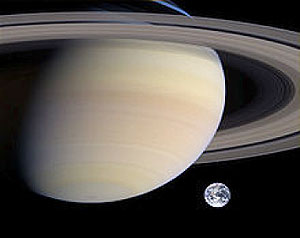Saturn is the sixth planet from the Sun and the second largest planet in the Solar System, after Jupiter. Saturn, along with Jupiter, Uranus and Neptune, are classified as gas giants. Together, these four planets are sometimes referred to as the Jovian, meaning “Jupiter-like”, planets.


Saturn is the sixth planet from the Sun and the second largest planet in the Solar System, after Jupiter. Saturn, along with Jupiter, Uranus and Neptune, are classified as gas giants. Together, these four planets are sometimes referred to as the Jovian, meaning "Jupiter-like”, planets.
Saturn is named after the Roman god Saturn, equated to the Greek Cronus (the Titan father of Zeus) the Babylonian Ninurta and to the Hindu Shani. Saturn’s symbol represents the god’s sickle.
The planet Saturn is composed of hydrogen, with small proportions of helium and trace elements (The term trace elements is used to describe a range of chemical elements that occur in very low concentrations which are vital for the growth, development and physiology of plants).
The interior consists of a small core of rock and ice, surrounded by a thick layer of metallic hydrogen and a gaseous outer layer.
The outer atmosphere is generally bland in appearance, although long-lived features can appear. Wind speeds on Saturn can reach 1,800 km/h, significantly faster than those on Jupiter.
Saturn has a planetary magnetic field intermediate in strength between that of Earth, and the more powerful field around Jupiter.
Saturn has a prominent system of rings, consisting mostly of ice particles with a smaller amount of rocky debris and dust. Sixty-one known moons orbit the planet, not counting hundreds of "moonlets” within the rings.
Titan, Saturn’s largest and the Solar System’s second largest moon (after Jupiter’s Ganymede), is larger than the planet Mercury and is the only moon in the Solar System to possess a significant atmosphere.
A rough comparison of the sizes of Saturn and Earth.
Rotation
As Saturn travels around the sun, it spins on its axis, an imaginary line drawn through its centre. Saturn’s axis is not perpendicular (at an angle of 90 degrees) to the planet’s path around the sun. The axis tilts at an angle of about 27 degrees from the perpendicular position.
Saturn rotates faster than any other planet except Jupiter. Saturn spins around once in only 10 hours 39 minutes, compared to about 24 hours, or one day, for Earth.
The rapid rotation of Saturn causes the planet to bulge at its equator and flatten at its poles. The planet’s diameter is 8,000 miles (13,000 kilometers) larger at the equator than between the poles.
A dense layer of clouds covers Saturn. Photographs of the planet show a series of belts and zones of varied colours on the cloud tops. This banded appearance seems to be caused by differences in the temperature and altitude of atmospheric gas masses.
Density and mass
Saturn has a lower density than any other planet. It is only about one-tenth as dense as Earth, and about two-thirds as dense as water. That is, a portion of Saturn would weigh much less than an equal portion of Earth, and would float in water.
Although Saturn has a low density, it has a greater mass than any other planet except Jupiter. Saturn is about 95 times as massive as Earth. The force of gravity is a little higher on Saturn than on Earth. A 100-pound object on Earth would weigh about 107 pounds on Saturn.
Saturn’s Rings
The rings of Saturn surround the planet at its equator. They do not touch Saturn. As Saturn orbits the sun, the rings always tilt at the same angle as the equator.
Saturn’s major rings are extremely wide. The outermost ring, for example, may measure as much as 180,000 miles (300,000 kilometers) across. However, the rings of Saturn are so thin that they cannot be seen when they are in direct line with Earth.
They vary in thickness from about 660 to 9,800 feet (200 to 3,000 meters). A space separates the rings from one another. Each of these gaps is about 2,000 miles (3,200 kilometers) or more in width. However, some of the gaps between the major rings contain ringlets.
The dark side of Saturn’s rings was photographed by Voyager 1 as it flew by the side opposite the sun.
Saturn’s rings were discovered in the early 1600’s by the Italian astronomer Galileo.
Galileo could not see the rings clearly with his small telescope, and thought they were large satellites. In 1656, after using a more powerful telescope, Christiaan Huygens, a Dutch astronomer, described a "thin, flat” ring around Saturn. Huygens thought the ring was a solid sheet of some material.
In 1675, Giovanni Domenico Cassini, an Italian-born French astronomer, announced the discovery of two separate rings made up of swarms of satellites.
Ends


